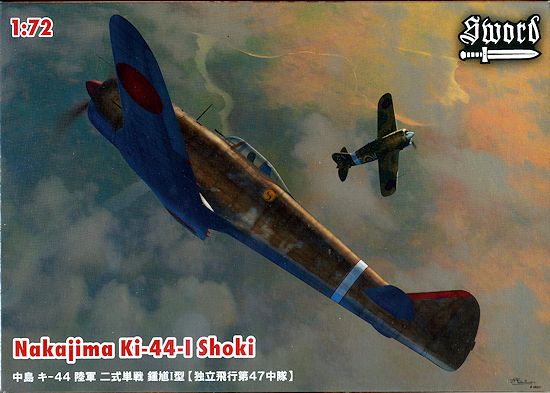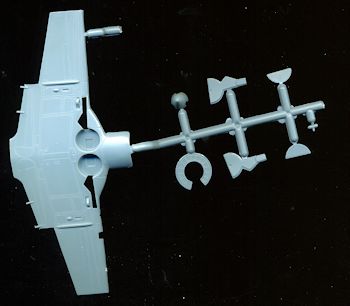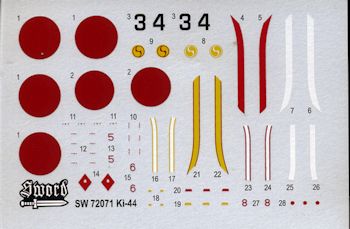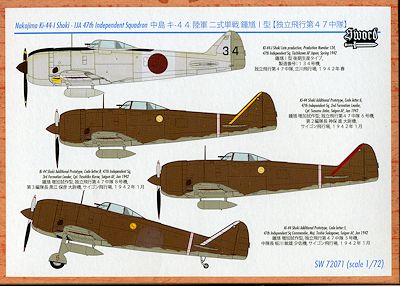
Sword 1/72 Ki-44-I 'Tojo'
| KIT #: | SW72042 |
| PRICE: | $32.99 SRP |
| DECALS: | Four options |
| REVIEWER: | Scott Van Aken |
| NOTES: | New tool kit |

| HISTORY |
The Nakajima Ki-44 Shōki (鍾馗, Zhong Kui) was a single-engine fighter aircraft used by the Imperial Japanese Army Air Force in World War II. The type first flew in August 1940 and entered service in 1942. The Allied reporting name was "Tojo"; the Japanese Army designation was "Army Type 2 Single-Seat Fighter" (二式単座戦闘機).
It was less maneuverable than its predecessor, the nimble Ki-43, and pilots disliked its poor visibility on the ground, its higher landing speed, and severe restrictions on maneuvering. Yet, the Ki-44 was superior in flight tests. It was an outstanding interceptor and could match Allied types in climbs and dives, giving pilots far more flexibility in combat. Moreover, the armament (including in some versions two 40 mm cannons) was far superior to the older Ki-43. These characteristics made the fighter an effective B-29 Superfortress destroyer and one of the Japanese High Command priorities during the last year of war. But poor pilot training in the last part of the conflict often made them easy targets for Allied pilots.
Initially, the Ki-44 was armed with two 7.7mm guns in the cowling and two 12.7mm guns in the wings. The prototypes were sent to Saigon early in the Pacific War to see how they performed against current Allied types. The results were fairly good, though serviceability of the prototypes was not the best. Apparently it was good enough and series production soon got underway.
| THE KIT |
 To
my knowledge, this is the second Sword boxing of the Ki-44 and this time it is
the -1 variant. In fact, the kit includes all the proper bits to do the
prototypes, something that has not been offered before in this scale. What Sword
has done is to provide the earlier kit with an additional sprue containing all
the unique bits for the prototypes and the -I version.
To
my knowledge, this is the second Sword boxing of the Ki-44 and this time it is
the -1 variant. In fact, the kit includes all the proper bits to do the
prototypes, something that has not been offered before in this scale. What Sword
has done is to provide the earlier kit with an additional sprue containing all
the unique bits for the prototypes and the -I version.
There is one large sprue for the injected parts with
resin being used for the engine and the seat. A nice clear sprue includes
landing light cover canopy and two windscreens as well as a gun sight. The
plastic is very well done with only a tad bit of flash. The interior is quite
well done. There is sidewall detail on the inside of the fuselage halves and on
the floor. Separate instrument panel, gun butts, control stick and rudder pedals
are included. A nice set of belts would have been nice, but you can find these
in the Eduard line. The tail wheel cavity also has frame detail and there is an
additional frame on which the strut attaches.
very well done with only a tad bit of flash. The interior is quite
well done. There is sidewall detail on the inside of the fuselage halves and on
the floor. Separate instrument panel, gun butts, control stick and rudder pedals
are included. A nice set of belts would have been nice, but you can find these
in the Eduard line. The tail wheel cavity also has frame detail and there is an
additional frame on which the strut attaches.
About the only thing the Ki-44 carried under its wings were fuel tanks and these are included, along with the side braces. All of these planes had the long gun barrels and typical of the time, the windscreen has an opening in it for a telescope to help in aiming. This is topped off with a nicely done separate canopy.
The additional sprue contains the new lower wing the circular oil cooler like on a Ki-27, a new pointed spinner for the prototypes, and new gear doors. The prototypes had a two piece gear door with a flap that fully enclosed the wheel well. Like just about all planes that initially had this feature, it was removed in production as it just caused trouble and did little to affect the speed of the plane. For the production -I you would leave these off and use the more rounded prop spinner on the old sprues.
 There are four options provided, three of them
are various prototypes, each differing by the color of the fin stripe. The
instructions state they are green upper surface, but frankly, it should be
something like a brown drab. They state the underside are grey, but again, I
think they were left unpainted. You may wish to do some more research in this
area. The fourth option is in overall unpainted aluminum with
There are four options provided, three of them
are various prototypes, each differing by the color of the fin stripe. The
instructions state they are green upper surface, but frankly, it should be
something like a brown drab. They state the underside are grey, but again, I
think they were left unpainted. You may wish to do some more research in this
area. The fourth option is in overall unpainted aluminum with white 'bandages' on the wings and fuselage as was used for home defense. These
white area will need to be painted in place as will the yellow wing ID areas.
There is no unit marking though it was with the 47th Independent Squadron, same
as the prototypes. This time back in Japan in early 1942, about the time of the
Doolittle raid.
white 'bandages' on the wings and fuselage as was used for home defense. These
white area will need to be painted in place as will the yellow wing ID areas.
There is no unit marking though it was with the 47th Independent Squadron, same
as the prototypes. This time back in Japan in early 1942, about the time of the
Doolittle raid.
The decals are very nicely printed. Instructions are also well done with color information provided during construction. There are also a number of information drawings to ensure that you have things properly placed or aligned.
| CONCLUSIONS |
A very welcome new kit for IJAAF fans and if you really want all of the Ki-44 variants in your 1/72 IJAAF collection, this one is a must have.
| REFERENCES |
http://en.wikipedia.org/wiki/Ki-44
January 2013 Thanks to Squadron Products
for the preview kit. Get yours today at your local shop. If you would like your product reviewed fairly and
fairly quickly, please
contact
me or see other details in the
Note to
Contributors.